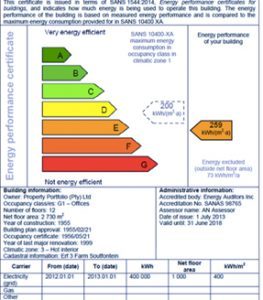Cape Town, 16 July 2021
Recently gazetted regulations published by the Department of Mineral Resources and Energy now make it compulsory for non-residential buildings in South Africa to declare their energy consumption by displaying an energy performance certificate at the entrance of their buildings. Building owners have until December 2022 to comply with these new building energy regulations, which require a formal assessment of your building energy consumption.
According to David Petrie, Technical Manager (Utilities) at FM Solutions Technical, these directives form part of the National Energy Efficiency Strategy under the National Energy Act, 2008 (Act No.34 of 2008), aimed at improving the country’s energy consumption. This process will determine the amount of energy that a specific building is allowed to consume per square metre. Similar energy performance certificate systems are currently in operation in the EU and the UK, where it was launched in 2007.

Above: An example of an Energy Performance Certificate that needs to be displayed at the entrance of all public buildings.
“It is important to note that the new legislation does not apply to factories and manufacturing plants. It applies to offices and public spaces, i.e. buildings that are used for entertainment and public assembly, theatrical and indoor sports activities as well as places of instruction,” Petrie explains.
These include schools, malls, theatres and places of work that are bigger than 2,000 square metres. Government buildings larger than 1,000 square metres must also comply with the new legislation. Buildings that have been in operation for less than 2 years, or have been subject to a major renovation within the past 2 years are exempted. Moreover, the new regulation stipulates that there are certain areas that can be excluded from the calculations, such as garages, car parks and storage areas.
“An Energy Performance Certificate, similar to those displayed on household appliances, must be issued by an accredited body in accordance with SANS 1544:2014 – Energy Performance Certificates for Buildings. This certificate must rank the energy rating (ER) of a building on a performance scale (A-G). This is to the maximum energy consumption (kWh/m²/a) per building type as per the SANS 10400 XA,” he says.
The certificate must be issued by a SANAS accredited body and also be submitted to the South African National Energy Development Institute. The Department of Mineral Resources and Energy will appoint inspectors to audit buildings for certificate compliance and validity. The certificates will be valid for a period of 5 years.

David Petrie, Technical Manager (Utilities) at FM Solutions Technical
As specialists in energy efficiency and energy management, FM Solutions Technical are regularly called upon by their clients to conduct the energy assessments. Petrie explains that this is not a one-size-fits all approach, as there are various important factors that need to be taken into consideration, including the physical location and the climatic zone of the premises, history of energy usage, size of the building and nature of the business.
“It is important to regularly conduct a detailed energy audit to identify the biggest electricity users. This allows landlords and tenants to consider replacing them with alternatives that would be more efficient and unlock significant savings in the long run. For this reason, we encourage organisations to adopt the new legislation as an opportunity to implement good practices that would benefit their bottom line and improve overall efficiencies,” he concludes.
For more information on how FM Solutions Technical can assist with Regulations for the Mandatory Display and Submission of Energy Performance Certificates for Buildings, please contact us.



Leave A Comment
You must be logged in to post a comment.